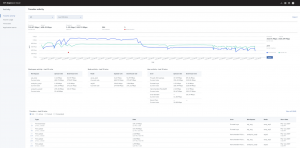NAB 2019: IBM Aspera Improves Cloud-Based Workflows, Streaming Accessibility
IBM Aspera (Booth SL5005) will showcase new functionality designed to enable reliable movement of media content with ever-increasing speed. New core performance enhancements bring multi-Gbps transfer speeds to both public and private cloud environments. Aspera will preview Aspera on Cloud automation capabilities, a new layer of cloud transfer security achieved through blockchain, and advancements in Aspera Streaming for Video.
 Delivering enhanced performance across the platform
Delivering enhanced performance across the platform
Aspera’s core FASP technology allows customers to reach ever-increasing transfer speeds. A new encryption module built around industry-standard OpenSSL AES-GCM encryption has been added to the Aspera High-speed Transfer platform, improving encrypted transfer rates by up to 200% while significantly reducing CPU load. In addition, the adaptable rate controller is more robust than ever, preventing overdrive failures when network conditions fluctuate.
Aspera multi-session transfer technology overcomes the inherent network speed limitations often found in cloud environments. By using parallel transfer processes to move very large files, Aspera is able to achieve multi-Gbps transfer speeds to and from all market leading clouds: IBM, AWS, Azure, and Google. An independent third-party performance analysis of IBM Cloud Object Storage with Aspera multi-session transfer and Amazon S3 with Transfer Acceleration found that the IBM technology completed a 20GB file transfer up to 12x faster than the competing technology. This technology is now in preview as part of the IBM Aspera Drive and Aspera Connect client applications.
SMPTE 2022-7
IBM Aspera will preview new Seamless Protection Switching capabilities that support the SMPTE 2022-7 standard. The redundant data transmissions created in accordance with these guidelines ensure that organizations are able to incorporate streaming over IP into critical workflows such as remote production and OTT delivery without the risk of falling behind or a connection being unexpectedly terminated. Aspera’s implementation of the standard enables unique, on-the-fly additions of redundant connections to existing transmissions, allowing for connection adjustments without disruption.
Microservices Architecture
Recent advancements in microservices architecture have enabled software developers to build massively scalable, reliable deployments of complex, interdependent applications. Open standards, such as Docker containers, Helm deployment charts, and Kubernetes orchestration platforms are driving the proliferation of highly available, self-healing workloads in the cloud. IBM Aspera’s modern, microservice architecture of Aspera High-Speed Transfer Server (v3.9.5) is currently available on IBM Cloud Private. The application allows an unlimited number of concurrent users to transfer files of any size at top speed using an Aspera client.
Facilitating cloud-based workflows
Across media and entertainment, more organizations are moving to modern, cloud-based IT infrastructures to meet growing demands for scale and flexibility. Aspera enables customers to leverage hybrid, multi-cloud deployments using IBM Aspera on Cloud as a hosted service for data transfer and management.
Since the launch of IBM Aspera on Cloud in April 2018, over 6,500 organizations have used the SaaS platform to send and receive nearly 50 petabytes of data. To achieve the scale and efficiency necessary for high-volume cloud-based workflows, Aspera on Cloud now offers new automation functionality to early-access customers. The automation helps users quickly configure recurring transfer workflows to streamline content delivery. These transfers can be triggered by a variety of events such as a submission to a Shared Inbox, content delivery to a shared folder, or a call out to an API. The web-based designer simplifies workflow creation using a drag-and-drop GUI. The flexibility of the automation engine allows for downstream processing tools from third-party vendors to be completely integrated into the workflows. This new cloud-based automation, combined with Aspera’s high-performance direct-to-cloud transfer technology and the scalability of the cloud, will transform content movement and processing.
In addition to the new automation application, the Aspera on Cloud Activity app has been updated to deliver comprehensive monitoring, and significant performance improvements. Expanded logging functionality is able to aggregate multi-session transfers into the monitoring view. All of this new data requires a performance visualization engine, so Aspera on Cloud now has a completely rebuilt Activity GUI that results in significantly increased performance while viewing the data.
Blockchain
Throughout their lifecycle, digital assets are exchanged between multiple parties and traverse many hosted services and multiple IT solutions that are more frequently being deployed into hybrid, multi-cloud infrastructures. To secure this content exchange and move high-speed workflows into the cloud, media organizations are seeking new protection strategies to lock down their assets and avoid content leaks. Available in preview, Aspera with IBM Hyperledger is an integrated solution that gives customers the ability to establish trusted business networks through an immutable chain of custody, build an additional layer of security around assets, enable forensic auditing, and reliably execute commercial contracts over the internet.
Expanding the accessibility of Aspera Streaming
IBM Aspera continues to push into new realms with innovative architecture for highly adaptable access and integration of its advanced FASP technology. This includes advancements in live and near-live video streaming at the highest bit-rates over commodity internet, even over great distances and when facing difficult network conditions.
Aspera will preview new capabilities in a beta release of Aspera Streaming for Video, which builds upon the next-generation Aspera FASP protocol with full bi-directional communication that allows FASP to substitute for TCP in any bulk transport application without modification. This enables the transport of live video from RTMP- and HTTP-based media servers and transcoders, IoT streams and live logging feeds for aggregation in cloud data analytics platforms, and support bulk content replication over the wide area network (WAN). This beta release will provide a full-fledged suite of software that can easily be deployed across servers, desktops, and mobile devices.
Aspera will also preview product innovations to help customers get up and running quickly and easily. The latest easy-to-use web application for Aspera Streaming for Video enables fast, simple set-up with auto-discovery of network streaming devices, centralized monitoring and management features, and full visibility of devices, streams, and connections.
